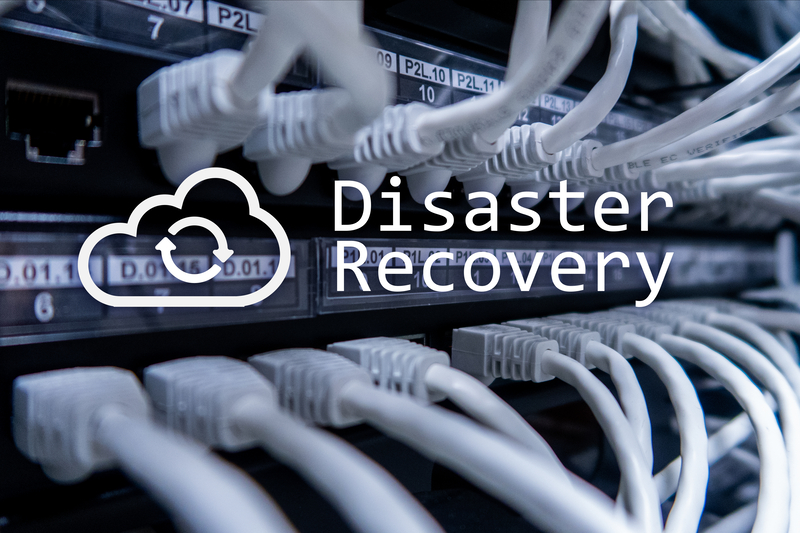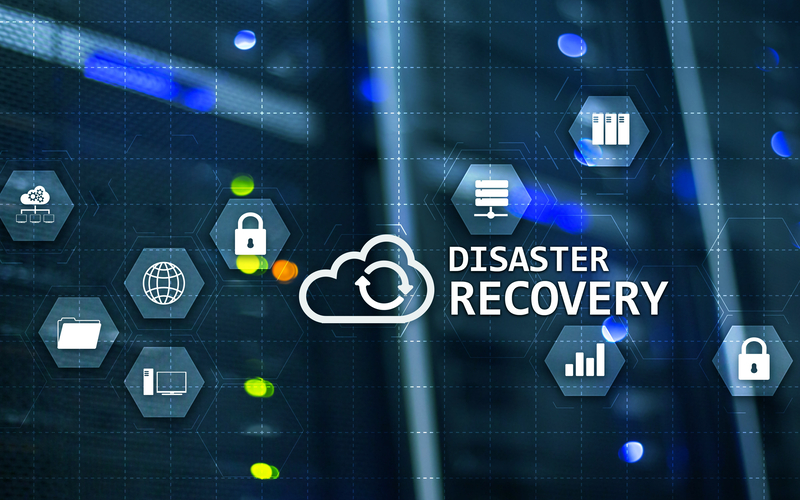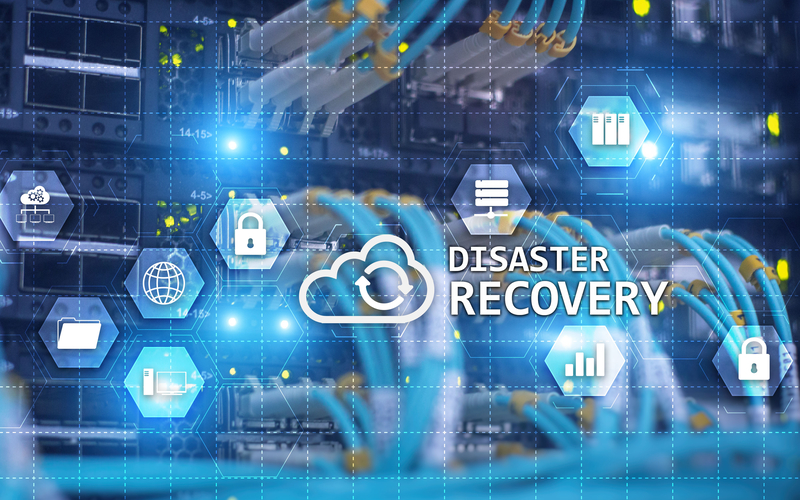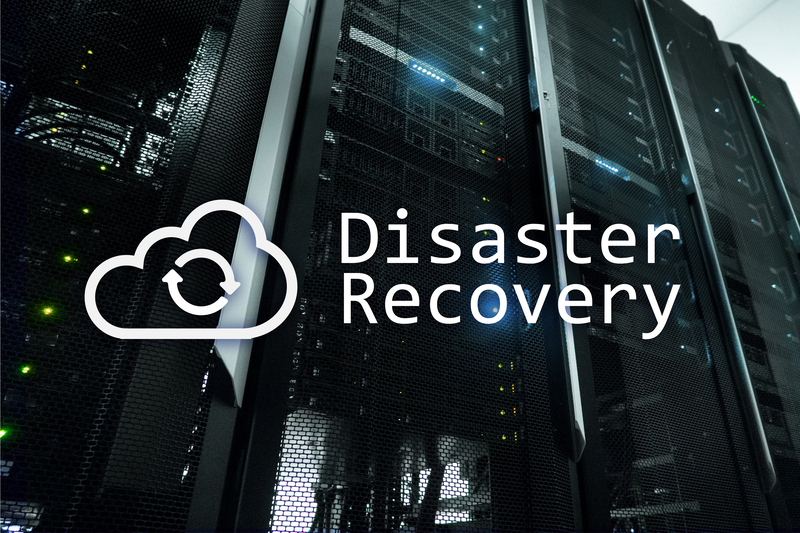Disaster recovery (DR) is a proactive planning approach for businesses and organizations to use to counteract the damaging impact of disruptions, downtime, or data loss when technology infrastructure fails.
While you can’t control when disasters strike, you can plan to minimize the impact on your business operations. Understand how disaster recovery works, why it’s essential for business continuity, and how to make a disaster recovery plan below.
How Does Disaster Recovery Work?

Having a data center operating your applications and systems through cloud computing is a great proactive measure. Servers impacted by natural disasters, power outages, ransomware or cyber-attacks, or equipment failure should have a safe location to back up data based on resource replication. There are several disaster recovery strategies to consider based on your unique needs.
Types of Disaster Recovery

- Data center disaster recovery: The entire building, including each feature, tool, physical security, support personnel, backup power, HVAC, utility providers, and fire prevention measures, is part of a disaster recovery protocol. If an outage occurs, each of these elements needs to function properly to reduce the damage that may occur in an unexpected event.
- Cloud-based disaster recovery: A cloud provider’s data center is the recovery site if something happens, which reduces the cost of relying on your facilities. Providers are typically responsible for the backup and recovery of all business-critical data.
- Virtualization disaster recovery: No need to reconfigure a physical server after a disaster hits. Instead, a virtual server can be hosted in the cloud or on a reserve capacity to meet your recovery point objectives (RPO) and recovery time objectives (RTO).
- Disaster recovery as a service (DRaaS): Everything is based in the cloud, and the most critical factor is where your provider’s data centers are. Knowing the location of off-premise data centers and how they’re storing your resources gives you a clear picture of what happens during a disaster.
Why is Disaster Recovery Essential?

Verizon’s 2022 Data Breach Incident Report found that 82% of breaches involve a human element, including social attacks, errors, and misuse. Disaster recovery is essential, and creating a plan helps you audit existing roles, IT systems, workloads, infrastructure, and tech practices and can identify potential risks before they impact your business.
Business continuity
Disaster recovery and your business continuity plan go hand in hand because you can’t have the other without one. Your disaster recovery plan ensures you don’t lose out on business from disruptive events that compromise data, automation, or applications.
Data protection
Secure data is critical, but the level of damage that lost information can have on a business is unique to its operations. There’s the impact of the data lost if the recovery time is extended or items cannot be recovered. There’s also the impact of downtime on brand reputation and data privacy laws. Your disaster recovery plan ensures you have a protocol to share internally and externally about keeping things running smoothly.
Customer retention
Customers can love your offerings, but the second they feel that their applications and data are no longer reliable, retention rates are at risk. Disaster recovery not only gives you a safeguard against challenges but also an important talking point with customers and prospects about why you’re a strong partner worth building a long-term relationship with.
Reduced costs
Disaster recovery can be cost-effective when considering the cost of losing data or downtime from an application or system failure. Every lost hour of productivity can mean lost sales, reduced revenue, or costly repairs if the physical infrastructure is involved. With a set plan for disaster recovery, it’s much easier to estimate the cost of an unexpected circumstance and plan to budget for emergencies.
How to Make a Disaster Recovery Plan (DRP)

A disaster recovery plan (DRP) is a way to organize and document your organization’s unique approach to handling unexpected events and recovering to normal operations as quickly as possible.
Define roles
Start with a clear disaster recovery team that practices preventative action all year, not just when a threat is indicated. This is your go-to team that everyone knows to turn to for any potential risks, primarily if a disaster occurs. Assign responsibilities with clear roles for each stakeholder to avoid any miscommunication when it matters most.
Complete a business impact analysis
Understand the assets you currently have and may gain in the future. This includes critical applications, resources, documentation, and procedures in place with off-site virtual machines. Each vendor should be able to walk you through their protocol for data backup. You should also know if you have a hot or cold site for disaster recovery based on the infrastructure you rely on.
When you identify your business-critical resources, you can prioritize them in your disaster recovery process. From there, you can establish metrics that measure your risk assessment and inform future initiatives.
Know your risks
If you’ve had prior disasters, you can identify risk areas that can be improved through your IT disaster recovery plan. If you haven’t, you can perform testing to determine the series of events that would prevent or inhibit a disruption like a cyber attack or outage.
Regular testing gives you the peace of mind of knowing things are running smoothly, and you can maintain connectivity. Determine how long it takes to recover information after a disaster and how to reduce it. This is also where details you might have yet to think about prior can come to light and be worked out within your IT team.
Build your communication plan
The most important part of your disaster recovery plan is how your team, vendors, and building personnel communicate. With so many outlets for information sharing available to businesses post-pandemic, it’s essential to know who to contact with real-time information and which outlet they regularly check to make sure to get all critical updates. This includes knowing who your point of contact is for any cloud storage vendors or disaster recovery sites and clarifying contact information to reach the right person at your organization.
Explore Disaster Recovery Solutions
Get one step ahead with disaster recovery services that help your business function. Ensure your information is protected in the cloud, enabling you to regain access to lost information, data analytics, and documents.
STEADfast IT is a trusted cloud services provider to help ensure business continuity as you grow and scale.
Services we Provide:
Similar Posts:
What Does IT Support Service Mean?
Why Do you Need a Business Phone System?
What is the Difference Between Speed and Bandwidth?
Why Should Your Business Move to the Cloud?
What is Spear Phishing in Cyber Security?
In-House vs Managed It Support
What is Cloud Service for Business?
Why is Data Security Important for Business?

